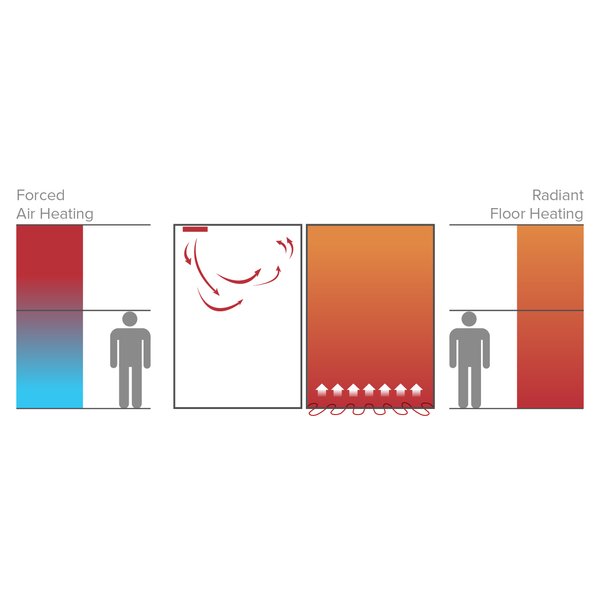If you’re not familiar with electric floor heating, you probably have no idea how cost effective or energy efficient it is. You might assume that because it’s a luxury upgrade that it’s expensive. Thankfully, that’s not the case. So how efficient is floor heating? In-floor heating systems are actually more economical than baseboard heaters and usually more energy efficient than forced-air systems. That’s because of the type of heat it provides and the way the heat is distributed.

Radiant floor-heating systems produce far infrared heat. It’s the same type of heat that you feel from the sun or a campfire. This heat works by warming people and objects directly instead of heating the air around them like forced-air systems do. As a result, the air temperature in a room can be lower while the people feel warmer because they are in direct contact with the floor-heating source.
Electric floor-heating systems use electric cable to deliver heat to the flooring surface above. They typically cover the majority of the square footage in a room, leading to an even distribution of heat from the floor up. In contrast, forced-air systems feature vents that blow warm air unevenly about a room. Vents are only located in strategic positions, so they can’t possibly heat an entire room evenly. Instead, they send warm air toward the ceiling where it eventually falls toward the floor once it’s cooled a bit. If your home is equipped with a forced-air system, this is why your feet often feel cold. This also results in having to run the heating system longer in order to get the comfort you want.

Finally, radiant heat is inherently efficient because it’s not susceptible to heat loss via ductwork. Forced-air systems are known for losing some heat through leaks in the ductwork. As long as a floor-heating system is properly insulated if it needs to be (it depends on the subfloor), the heat has nowhere to escape.
All of this results in a virtually 100 percent energy efficient heating source.
Floor-Heating Cost of Operation

Now we know that radiant floor heat is energy efficient, but is floor heating expensive to run? Because an electric floor-heating system is so energy efficient, it often translates to a lower utility bill. Of course, this depends on a variety of factors like how susceptible your room is to heat loss and how large the room is. But typically, it costs only pennies a day to heat a small room.
To find out how susceptible your room is to heat loss, use the WarmlyYours Heat Loss Calculator. To estimate how much it would cost to operate a floor-heating system in your particular space, use the WarmlyYours Operating Cost Calculator.
And of course, you can find out how much the system itself would cost by getting a free quote. The WarmlyYours Radiant Floor Heating Quote Builder quickly and easily explains the options available and lets you decide what works best for your budget and level of expertise.



Very helpful ! Thank you 😊
Do you have any references to back this up. I would be interested in how much of the heat is conducted into the ground below, rather than into the house.
Thank you for the great questions. Here are some helpful resources about the energy efficiency of radiant heating from the U.S. Department of Energy: https://www.energy.gov/energysaver/home-heating-systems/radiant-heating And Scientific American: https://www.scientificamerican.com/article/underloor-radiant-heating/ Regarding your second question about how much of the heat is absorbed into the ground below the system, this is only typically an issue if you’re installing radiant heating over an uninsulated space (like a garage) or over a concrete slab. In either case, making use of an insulating underlayment can help function as a thermal break which will allow more of the energy to radiate upwards into the room instead of being lost to “heat sink” into the subfloor. Here’s a case study about the use of our CeraZorb synthetic cork insulating underlayment: http://warmlyyours.com/publications/CERAZORB-ENERGY-EFFICIENCY-REPORT-A.pdf Hope that helps!
Is it better to keep electric floor heating set at a consistent temperature around the clock or use a program to lower the temperature during times away from the house and during the night?
Generally speaking it's better to use a programmable thermostat with your floor heating system for times in which you know you'll either be away from the house or you will be sleeping. The warm-up times for electric floor heating are pretty fast so you can just set your system up to turn on slightly before you'll actually be using the floor and you'll experience no interruption of comfort while significantly cutting down on energy use.